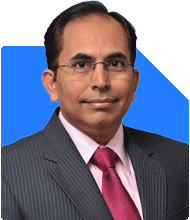Ramalingam Kalirajan |10870 Answers |Ask -Follow
Mutual Funds, Financial Planning Expert - Answered on May 08, 2024
He has an MBA in finance from the University of Madras and is a certified financial planner.
He is the director and chief financial planner at Holistic Investment, a Chennai-based firm that offers financial planning and wealth management advice.... more

Iam 38 years old i need 5cr corpus in 55 years i have started sip of amount 7500 with 15% returns now value 1 lakh.
Goal: You aim to accumulate a corpus of 5 crore by the time you turn 55. This is a significant amount and requires disciplined investing over the years.
Current SIP: You've started with a monthly SIP of 7500 with an assumed return rate of 15%. At present, your SIP value is 1 lakh.
Investment Strategy:
Increase SIP Amount: Consider gradually increasing your SIP amount over time. As your income grows or expenses decrease, channel a higher portion towards your investments.
Diversify Portfolio: While it's great to have high-return expectations, it's crucial to diversify your portfolio to manage risk. Consider investing in a mix of equity, debt, and other asset classes.
Regular Review: Regularly review your investment portfolio and adjust your SIP amount or asset allocation as needed. Market conditions and personal circumstances can change, so it's essential to stay flexible.
Long-Term Perspective: Keep in mind that building a 5 crore corpus over the next 17 years requires patience and discipline. Stick to your investment plan even during market fluctuations, and avoid making impulsive decisions.
Professional Guidance: Consider consulting a Certified Financial Planner (CFP) to fine-tune your investment strategy and ensure it aligns with your financial goals and risk tolerance.
Emergency Fund: While focusing on long-term goals, don't forget to maintain an emergency fund to cover unexpected expenses. Aim for at least 6-12 months' worth of living expenses in a liquid and easily accessible account.
By following a systematic investment approach, staying committed to your financial goals, and seeking professional advice when needed, you can work towards building a substantial corpus for your future.
Best Regards,
K. Ramalingam, MBA, CFP,
Chief Financial Planner,
www.holisticinvestment.in
You may like to see similar questions and answers below
Ramalingam Kalirajan |10870 Answers |Ask -Follow
Mutual Funds, Financial Planning Expert - Answered on Apr 30, 2024
Ramalingam Kalirajan |10870 Answers |Ask -Follow
Mutual Funds, Financial Planning Expert - Answered on May 20, 2024
Ramalingam Kalirajan |10870 Answers |Ask -Follow
Mutual Funds, Financial Planning Expert - Answered on Jul 11, 2024
Ramalingam Kalirajan |10870 Answers |Ask -Follow
Mutual Funds, Financial Planning Expert - Answered on Jul 04, 2025
Janak Patel |71 Answers |Ask -Follow
MF, PF Expert - Answered on Aug 04, 2025
Dr Dipankar Dutta |1836 Answers |Ask -Follow
Tech Careers and Skill Development Expert - Answered on Dec 05, 2025
Ulhas Joshi |280 Answers |Ask -Follow
Mutual Fund Expert - Answered on Dec 05, 2025
Dr Dipankar Dutta |1836 Answers |Ask -Follow
Tech Careers and Skill Development Expert - Answered on Dec 04, 2025
Ravi Mittal |676 Answers |Ask -Follow
Dating, Relationships Expert - Answered on Dec 04, 2025
Anu Krishna |1745 Answers |Ask -Follow
Relationships Expert, Mind Coach - Answered on Dec 04, 2025
Anu Krishna |1745 Answers |Ask -Follow
Relationships Expert, Mind Coach - Answered on Dec 04, 2025
Mayank Chandel |2562 Answers |Ask -Follow
IIT-JEE, NEET-UG, SAT, CLAT, CA, CS Exam Expert - Answered on Dec 04, 2025
Mayank Chandel |2562 Answers |Ask -Follow
IIT-JEE, NEET-UG, SAT, CLAT, CA, CS Exam Expert - Answered on Dec 04, 2025
Mayank Chandel |2562 Answers |Ask -Follow
IIT-JEE, NEET-UG, SAT, CLAT, CA, CS Exam Expert - Answered on Dec 04, 2025
Mayank Chandel |2562 Answers |Ask -Follow
IIT-JEE, NEET-UG, SAT, CLAT, CA, CS Exam Expert - Answered on Dec 04, 2025

























